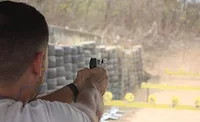FBI Report Details Commonalities Among Active Shooters
A new FBI report on active shooters says that mass shooters don’t explode out of nowhere—they plan and prepare. Most have no diagnosable mental illness. And their attacks are almost always preceded by behaviors that stir apprehension in people close to them, possible warning signs that crop up over a lengthy period of time.
The study, coauthored by criminal justice professor James Silver of Worcester State University and Supervisory Special Agent Andre Simons and Dr. Sarah Craun of the FBI’s Behavioral Analysis Unit, examined 160 active shooter incidents between 2000 and 2013.
The study said that active shooters don't burst out of extreme social isolation. Most lived with or had social connections to other people—who were likely to have witnessed disturbing pre-attack behaviors. Those behaviors most commonly involved mental health problems related to anger, paranoia, or depression; troubling levels of interpersonal conflict; or communicated threats of violence.
According to the study, on average, each of the 63 active shooters displayed four to five troubling behaviors that were observable to people around them, such as classmates, friends, teachers, spouses, or domestic partners. In a majority of the cases, the first known instance of troubling behavior came more than two years prior to the attack.
According to the study more than three quarters of the killers spent a week or longer planning their attacks, while two thirds spent at least a month planning, and some spent far longer. About half of the shooters took a week or longer to carry out preparations for their attacks, including obtaining firearms, ammunition, and body armor or other tactical gear.
The study also notes that there is no demographic profile for active shooters. The vast majority were male (all but 4 of the 63), about two thirds were white, while others were black, Asian, Hispanic, Middle Eastern, and Native American. The shooters ranged in age from 12 to 88. The largest age group, nearly a third of all the attackers, was 40- to 49-year-olds.
Regarding mental illness, the FBI could only verify that 25 percent of the active shooters were known to have been professionally diagnosed with a mental illness of any kind prior to their attacks. Only three cases involved a psychotic disorder.
In addition, the study notes that active shooters most often have personal connections to the sites they attacked, which in the past, has usually been a current or former workplace, or a current or former school.
Looking for a reprint of this article?
From high-res PDFs to custom plaques, order your copy today!



